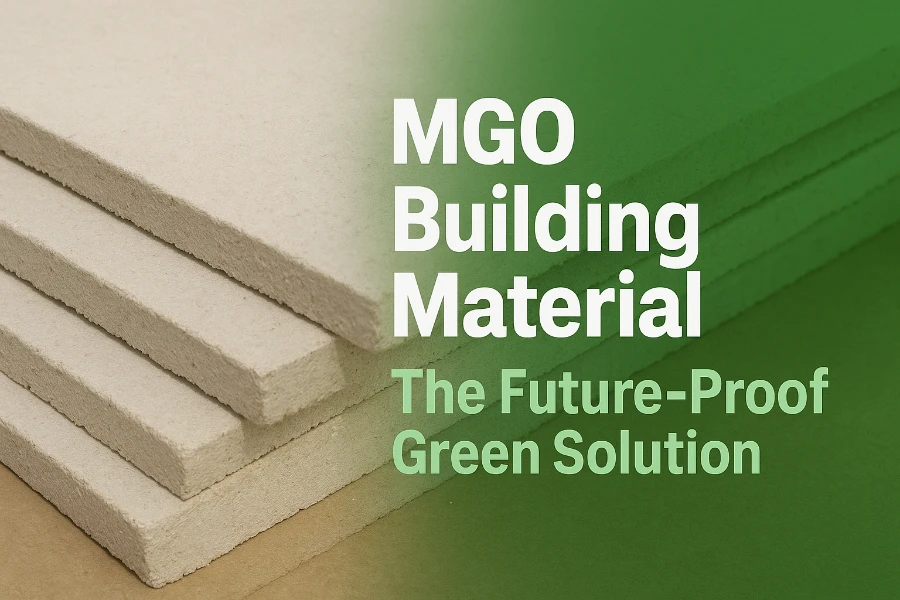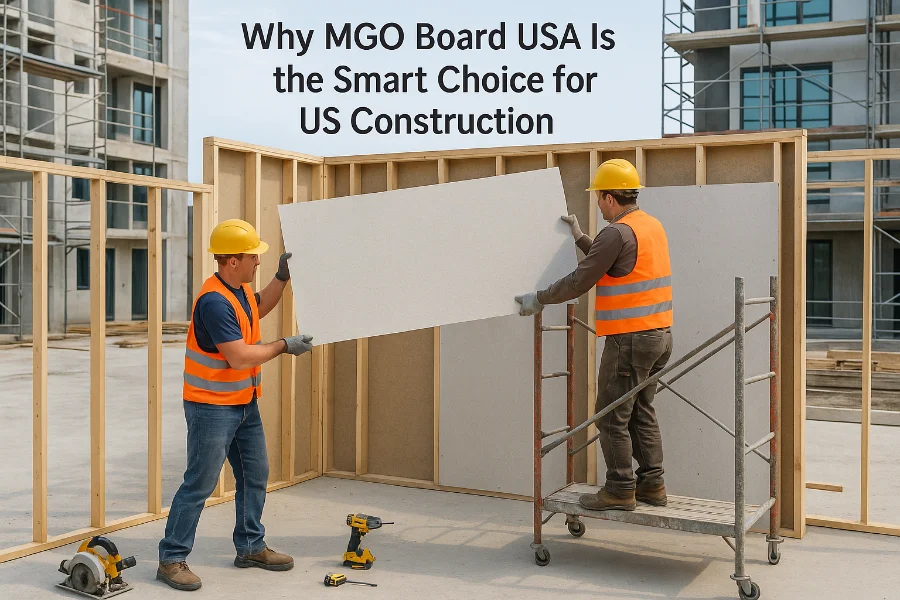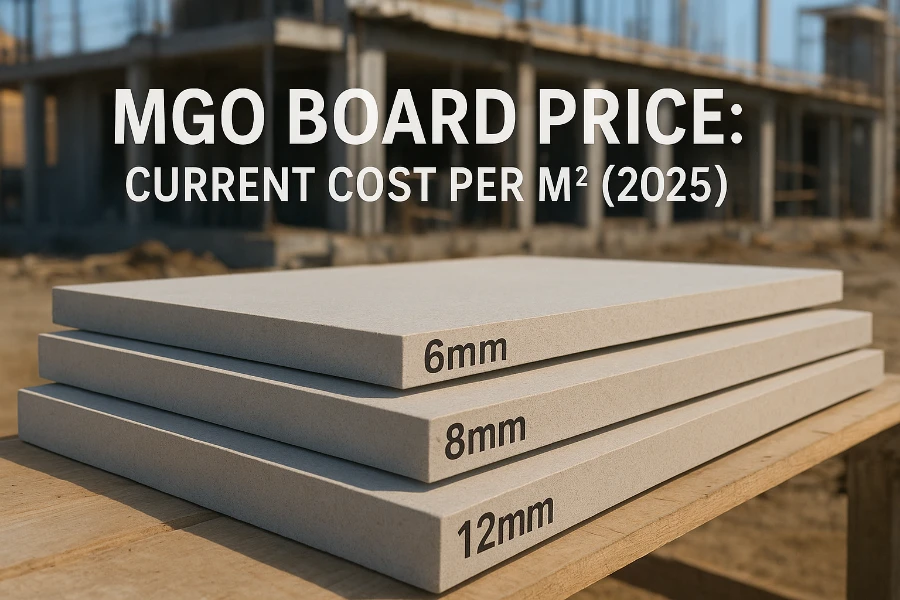Table of Contents
Introduction
The construction industry is rapidly evolving, with growing emphasis on sustainable design, fire safety, and long-term durability. Among the many innovative solutions available today, magnesium oxide building material has gained recognition as a high-performance alternative to traditional options like gypsum, plywood, and fiber cement.
Magnesium oxide, commonly referred to as MgO, is an eco-friendly and non-combustible material manufactured from natural mineral sources. In board or panel form, magnesium oxide building material offers an impressive combination of fire resistance, moisture protection, strength, and versatility. These qualities make it highly suitable for modern residential, commercial, and institutional projects.
What sets this material apart is not only its technical performance but also its alignment with sustainable construction goals. As builders and architects increasingly seek materials that reduce environmental impact while improving building efficiency, magnesium oxide boards stand out as a smart choice for both interior and exterior applications.
In this article, we will explore 10 practical and forward-looking applications of magnesium oxide building material in sustainable design. From walls and ceilings to flooring and roofing systems, MgO is shaping the future of modern construction.
1. Interior Wall Partitions
One of the most common applications of magnesium oxide building material is in interior wall partitions. In modern residential, commercial, and institutional projects, lightweight partition walls are preferred over traditional masonry because they are easier to install, more cost-effective, and allow for flexible space design.
Magnesium oxide panels, also called MgO boards, are an excellent replacement for gypsum drywall. Unlike gypsum, which can be easily damaged by water or mold, magnesium oxide boards are naturally resistant to moisture and fungal growth, making them ideal for offices, hospitals, or apartments.
Another key advantage is fire safety. Interior partitions made from magnesium oxide building material have a high fire-resistance rating, providing added protection in case of an emergency. Their strength and durability also allow finishes such as paint, wallpaper, or laminate to remain intact over time. For developers and architects pursuing sustainable design, magnesium oxide boards reduce maintenance costs, improve indoor air quality, and contribute to long-term building performance.
2. Exterior Wall Systems
Beyond interior use, magnesium oxide building material plays a crucial role in exterior wall systems. Traditional exterior cladding materials, such as plywood, OSB, or cement boards, often face challenges like swelling, warping, or deterioration under prolonged exposure to rain, UV radiation, and temperature changes.
Magnesium oxide boards solve these issues with their superior weather resistance. They are dimensionally stable, meaning they do not expand or contract significantly with humidity or heat. When used as a substrate for siding, stucco, or ventilated façade systems, magnesium oxide board provides a reliable, long-lasting base that protects buildings from environmental stress.
Another significant benefit is energy efficiency. Exterior walls made with magnesium oxide boards contribute to better insulation and airtightness, reducing heating and cooling demands. This aligns perfectly with sustainable architecture principles, where energy savings are just as important as durability.
👉 Check if mgo board is waterproof
3. Ceilings and Acoustic Panels
Ceilings are essential for both aesthetics and building performance, including fire safety and acoustic comfort. Magnesium oxide building material demonstrates its versatility in these applications.
MgO panels are lightweight yet structurally stable, making them an excellent choice for suspended ceilings. Their non-combustible nature enhances fire resistance, providing additional safety in offices, schools, hospitals, and public buildings.
Magnesium oxide boards can also be engineered into acoustic panels that absorb sound and reduce noise transfer between rooms. Unlike traditional gypsum or mineral fiber boards, magnesium oxide board is resistant to moisture and mold, ensuring ceilings remain clean and durable even in humid environments.
4. Flooring and Sub-Flooring
Flooring systems must withstand constant foot traffic, heavy loads, moisture, and potential fire risks. Traditional plywood or particleboard floors can warp or degrade over time. Magnesium oxide building material offers a durable and moisture-resistant solution for flooring and sub-flooring applications.
MgO boards provide a stable base for tiles, vinyl, laminate, or carpet, ensuring that finish layers maintain their integrity for years. Their fire resistance also helps structures meet building codes, while dimensional stability keeps floors level even under challenging environmental conditions.
In sustainable construction projects, using magnesium oxide panel in flooring reduces lifecycle costs by minimizing repairs and replacements, providing both safety and longevity.
5. Roofing Systems
Roofs are the first line of defense against external elements like rain, wind, snow, and fire. Traditional substrates, such as plywood or OSB, are vulnerable to moisture absorption, warping, and decay. Magnesium oxide building material offers a highly durable and weather-resistant solution for modern roofing systems.
MgO boards are dimensionally stable, ensuring a long-lasting base that prevents cracks and maintains the integrity of shingles, membranes, or tiles installed above. The non-combustible nature of mgo board adds an extra layer of fire safety, which is increasingly important in wildfire-prone regions and urban developments.
Additionally, MgO’s resistance to mold and mildew ensures roofs remain clean and durable even in humid climates. By reducing the risk of biological growth and structural damage, magnesium oxide boards contribute to sustainability and lower maintenance costs, making them a smart choice for green construction.

6. Sheathing for Exterior Walls
Exterior wall sheathing protects a building’s structure and provides a stable surface for cladding systems. Wood-based products often face rot, insect damage, and reduced fire resistance. Magnesium oxide building material is an ideal alternative.
MgO boards deliver exceptional fire resistance and moisture protection, ensuring walls do not warp or degrade. Their breathability allows walls to release moisture vapor while still acting as a barrier, reducing condensation and mold growth. This enhances indoor air quality and prolongs the lifespan of the structure.
From a sustainability perspective, magnesium oxide boards support energy-efficient construction by providing a solid base for insulation and cladding systems, helping meet modern thermal and environmental standards.
7. Interior Wall Partitions
In offices, residential complexes, and public facilities, interior partitions define spaces while ensuring comfort and safety. Traditional drywall often lacks the durability and fire resistance required in modern buildings. Magnesium oxide building material is a superior choice for these applications.
MgO boards are lightweight yet strong, easy to install, and offer excellent acoustic performance, reducing sound transmission between rooms. Their fire-resistant and moisture-resistant properties make partitions safe, durable, and low-maintenance, aligning with sustainable construction practices.
8. Fire-Rated Doors
Fire-rated doors are essential for preventing the spread of flames and smoke during emergencies. The core material greatly affects door performance. Magnesium oxide building material is increasingly used as a core or facing layer in fire-rated door systems.
MgO’s non-combustible properties allow doors to withstand direct fire exposure for extended periods. Its dimensional stability ensures doors remain functional under changing humidity conditions, and its impact resistance enhances durability in high-traffic areas. Using magnesium oxide boards in fire doors also supports greener construction by reducing reliance on chemically treated wood.
9. Decorative Finishes and Panels
Magnesium oxide building material is not only functional but also versatile for decorative purposes. Architects and designers value MgO panels for their ability to combine aesthetics with durability.
MgO can be finished with paint, veneers, laminates, or textured coatings, making it suitable for decorative walls, ceilings, or feature panels. Unlike gypsum boards, magnesium oxide boards resist yellowing, warping, and cracking, ensuring long-lasting appearances.
Additionally, magnesium oxide boards provide a stable substrate for tiles, wallpaper, or PVC films, allowing designers to achieve creative effects without compromising on fire safety or moisture resistance.
10. Prefabricated Building Systems
Prefabrication and modular construction are increasingly popular for fast, green, and efficient building methods. Magnesium oxide building material is ideal for these systems due to its strength, light weight, and durability.
MgO boards are integrated into factory-produced wall panels, floors, and ceilings, which are then transported to construction sites for rapid assembly. Their fireproof and weather-resistant properties make them suitable for housing, schools, and emergency shelters. MgO boards also improve energy efficiency when paired with insulation layers, reducing heating and cooling demands. Prefabricated systems using magnesium oxide boards help deliver safer, sustainable, and cost-effective projects.
Conclusion
Magnesium oxide building material is a versatile and sustainable solution for modern construction. From interior partitions and ceilings to exterior sheathing, roofing, flooring, fire-rated doors, decorative panels, and prefabricated systems, magnesium oxide boards combine fire resistance, moisture protection, durability, and eco-friendliness in a single material.
As the construction industry emphasizes safety, sustainability, and long-term performance, magnesium oxide building material stands out as a smart choice for architects, builders, and developers. Its adaptability across diverse applications allows professionals to create spaces that are safe, efficient, and environmentally responsible.
If you are exploring materials that can enhance fire safety, resilience, and sustainability in your projects, our experts at Suparna MgO Board are ready to provide guidance and technical insights. We can help you understand how this material can fit into your building requirements, ensuring projects meet both performance and sustainability goals.
Discover why MGO building material is the future-proof green solution for durable, fire-resistant, and eco-friendly construction projects.
Discover why MGO board USA is the smart choice for American construction—fire-resistant, durable, eco-friendly, and compliant with US building standards.
Discover the current MGO board price per m² in 2025. Learn factors affecting cost, compare with fiber cement boards, and get tips to save on your project.




